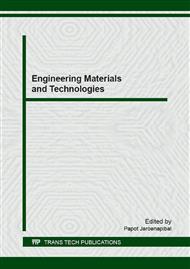p.120
p.129
p.133
p.139
p.143
p.148
p.157
p.163
p.169
Utilization of Pottery Stone as a Replacing Material for Vitreous Ceramic Sanitary Ware Production: A Case Study in Khon Kaen, Thailand
Abstract:
The aim of this work was to determine the properties of vitreous ceramic sanitary ware bodies according to the production of Khon Kaen ceramic sanitary ware industry, Thailand. Pottery stone was used as a replacing material in the commercial ceramic sanitary ware body formulation. The cast slurry of seven formulations was prepared by wet milling. The rheological properties (density and torsion viscosity) were investigated before slip casting. The test pieces were fired at 1175, 1200 and 1225๐C and the physical-mechanical properties (firing shrinkage, flexural strength, and water absorption) were compared. As a result, pottery stone shows a possibility to replace quartz in the production. It could enhance all of the good properties at lower firing temperature. Using of pottery stone could reduce production cost in term of energy fuel by 4.45% when compared with commercial formulation.
Info:
Periodical:
Pages:
143-147
Citation:
Online since:
November 2016
Price:
Сopyright:
© 2017 Trans Tech Publications Ltd. All Rights Reserved
Share:
Citation:


